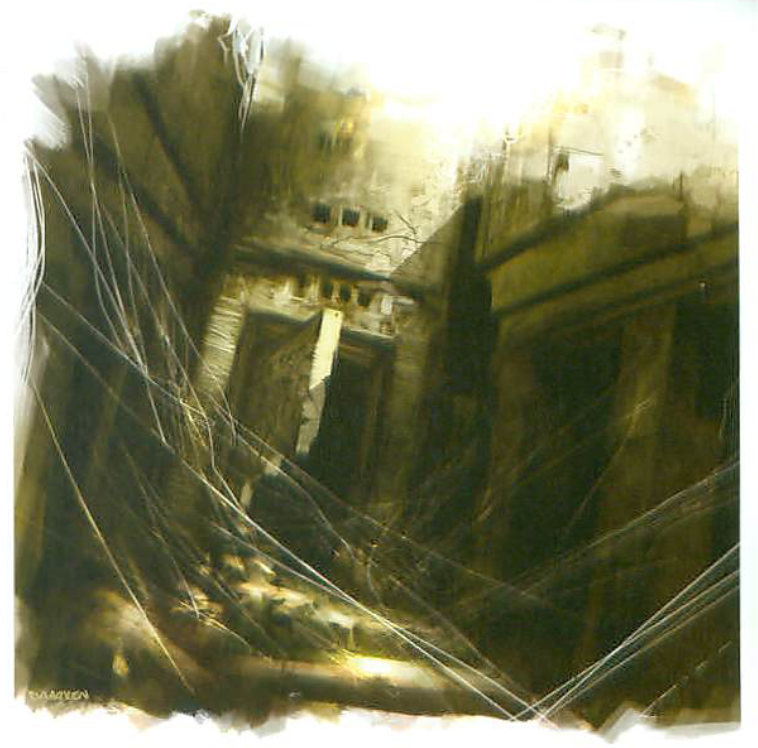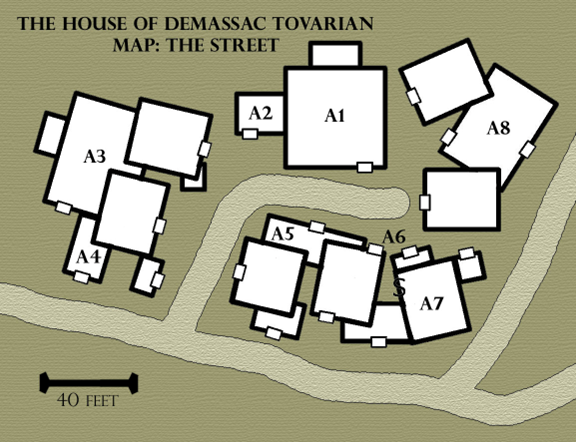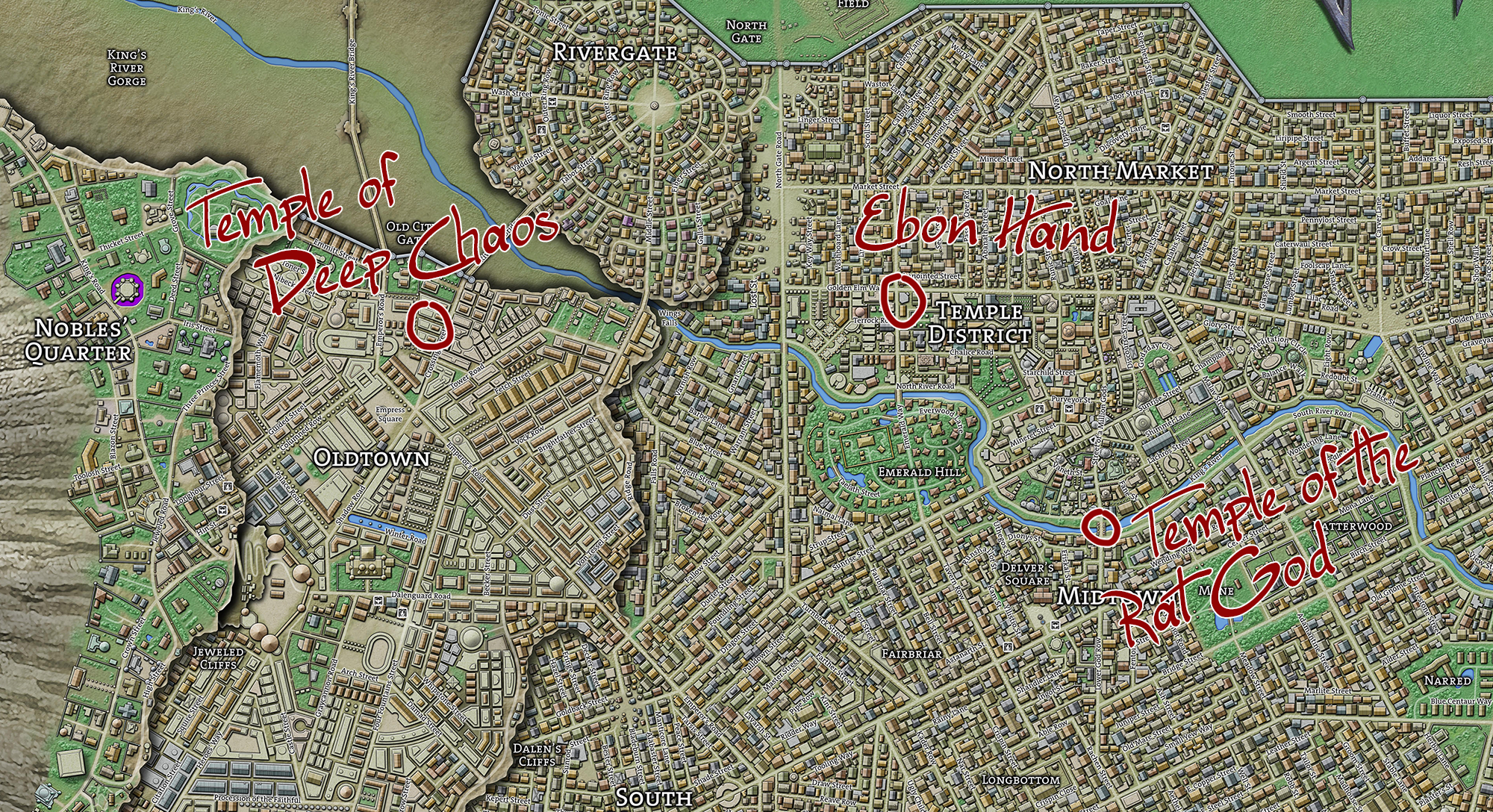 IN THE SHADOW OF THE SPIRE
IN THE SHADOW OF THE SPIRE
SESSION 36D: CRYPT OF WEBS
January 24th, 2009
The 19th Day of Kadal in the 790th Year of the Seyrunian Dynasty

Being tethered to the Banewarrens – effectively limiting their actions east of Oldtown – was becoming completely untenable. Their affairs in the Banewarrens required them to seek out Alchestrin’s tomb, but the Necropolis was well out of the range.
To solve the problem once and for all, Ranthir spent the next couple of hours tracking down several scrolls which described the arcane creation of a small missive token that would allow its holder to communicate a brief message directly to his ears… no matter the distance between them.
In short order, Ranthir was able to give one of these tokens to Kalerecent. If Kalerecent’s guard upon the Banewarrens were disturbed, he could instantly summon them.
“Oh, good,” Dominic said. “And we’ll only be a quick half hour away. I’m sure he’ll be fine.”
Tee shrugged. “That’s no worse than what we were doing before.”
“The only other option,” Ranthir said, “Is for us to camp in the Banewarrens until the green-haired hag comes out.”
That didn’t sound like much fun. And there were too many other things demanding their attention…
CRYPT OF WEBS
It was only a couple of hours before dusk and the sun was already low in the sky, but they felt they had already wasted enough time. They headed to the Necropolis, aware that they would need to finish their work there before darkness fell.
Once they had reached Darklock Hill, Dominic used his connection with the gods to fixate upon Alchestrin’s sigil and locate its nearest occurrence. He led them to a crudely built crypt with thick walls built from heavy stone slabs. Elestra recognized that these slabs were, in fact, repurposed stone sarsens. Several of them had the distinctive – yet heavily worn – sigil of Alchestrin worked into them.

On one side of the crypt there was a badly rusted iron door. It was, in fact, rusted shut. Tee and Agnarr were able to pry out the hinges and lever out the door with a minimal amount of fuss and noise. On the other side there was a flight of gloom-shrouded stairs leading down about twenty feet.
Tee led the way into a long entry hall strewn with rubbled stone from the broken walls and ceiling. Thick cobwebs were strung from the walls, although there was a more or less clear path to the heavy door of stone that hung half-open – its bottom smashed apart – at the far end of the hall. Four open arches led off form the hall, two to the left and two to the right.
Choosing at random, Tee headed towards the first arch on the left. It opened into a small burial chamber, with an upright sarcophagus standing against the far wall. The sarcophagus itself had been smashed apart. The corpse of its former inhabitant lay on the floor in the middle of the chamber – thick webs seeming to manacle the dried husk to the walls. The chest of the corpse appeared to have been ripped open.
Tee quickly inspected the corpse, but found little of interest. (Perhaps if she had recognized the damage to its chest as an exit wound they might have had some warning of what was to come.) She turned back to the others to report, but spotted movement in the webs of the opposite room. Acting on pure instinct, she whipped out her dragon pistol and fired.
The shot harmlessly blasted away a patch of web, but a moment later a carpet of large, reddish spiders poured out of the room. In the entry hall, Agnarr, whirling towards the spot Tee had shot, was suddenly covered in the things – they bit him repeatedly, sending a rush of painful venom into his bulging veins.
With a roar of rage and a mighty cry, Agnarr swung his flaming sword through the spiders, using the flat of his blade to crush those crawling up his legs.
Elestra, thinking quickly, dropped a ball of magical flame into the middle of the spiders, but they swarmed away from it and over the top of the others – biting at every bit of exposed flesh they could find.
Dominic ran for it, heading back up the stairs and escaping the worst of it. But by the time Agnarr was able to scatter the swaming mass, Ranthir had been badly hurt – the painful, fist-sized welts leaving him gasping for breath.
But when Elestra laid her hands on him and sent a burst of healing energy into his body, Ranthir screamed in pain and collapsed.
Dominic, who was coming back down into the crypt after hearing the all-clear from Agnarr, heard the scream and hurried down the last few steps. “What happened?”
“I don’t know!” Elestra knelt next to Ranthir, trying to figure out what had gone wrong. But her further ministrations only made things worse. Even the slightest touch of positive energy raised vicious welts and gaping wounds on the unconscious mage.
But even as she was focusing on Ranthir’s dilemma, Elestra was using the back of her mind to guide her flaming sphere into one of the other web-choked crypts.
As the webs began to burn, a web-wrapped mummy stumbled through the crypt’s arch and attacked Tee from behind. Agnarr charged the sudden foe, shoving Tee out of the way, even as a second web mummy emerged into the entry hall.
Agnarr made quick work of his first foe: His sword cleaved the mummy’s chest in twain. But no sooner had the top half of the mummy fallen to one side than more of the crypt spiders began to pour out of the severed torso. Tee, in a panic, fired at the already dismembered corpse. This had little effect, but Agnarr – thinking quickly – plunged his blade into the mass and used it to create a sudden pyre.
But with his weapon thus preoccupied, Agnarr made an easy target for the second mummy – who clubbed him over the back of the head. As the barbarian fell, however, Tor moved to block it from attacking the others. As he shifted into position, the mummy brought both of its hands down on the kinght’s shoulders in a crushing blow. Tor could feel his spine compressing under the sheer force of the blow, but gritting his teeth he bore the pain and swung his sword strong.
The mummy’s head flew free… and spiders began to crawl out of its neckhole.
Tee, however, had retrieved a flask of oil from her bag of holding. She tossed it at the decapitated mummy’s corpse while Tor scooped up Agnarr’s sword and lit alight spiders and mummy alike.
SPIDER’S CRYPT
Now, however, the unconscious Agnarr was exhibiting the same symptoms as Ranthir. Any attempt to heal his wounds was backfiring.
However, Dominic – finally given the breathing room to give the afflicted a proper examination – was able to determine that the effect was being caused by the venom of the crypt spiders. Their mystical poison was creating an inversion of positive and negative energy, foully turning the life-touch of the gods to injurious pain.
Fortunately, Dominic knew a simple spell to suppress the effects of the venom. And the mystic properties of the poison were rapidly burning up in any case. It wouldn’t be long before those afflicted could be healed normally.
While Dominic was restoring Agnarr and Ranthir, Tee finished searching through the outer crypts. She found another corpse with its chest torn open (this one with a ruined shirt of mithril which had been torn asunder by the spiders) and in another sarcophagus she found a magical sword.
After much deliberation, however, they decided to leave these tombs (and their meager treasures) undisturbed. The strange, corpse-inhabiting spider swarms had already done enough to disturb the rest of those who had been buried here.
Tee therefore turned her attention to the door of broken stone at the end of the entry hall. Looking through it she could see an antechamber. A mosaic of glittering lapis lazuli depicting a bursting star had been worked into its floor. Twin statues with red gemstones in their eyes flanked a farther arch leading into the tomb beyond. Each of the statues was raising its right hand before it, as if to ward off trespassers. In the tomb itself she could see an iron sarcophagus worked in the likeness of a knight with a sword and shield laid upon its chest. Thick webs were draped from the sarcophagus, shrouding the far corners of the crypt in darkness.
Agnarr and Tor were able to wrench open the door. Convinced that the lapis lazuli floor was dangerous, Tee used her boots of levitation to reach the ceiling and pull herself across to the arch on the far side of the antechamber. Lowering herself to the floor there, she proceeded cautiously into the crypt on foot.
She had not gone far, however, when a gob of web suddenly flew through the air and clogged up the exit. Tee whirled to look at it, even as one massive, chitinous black leg descended from the ceiling above…
It was followed by seven more, encircling her completely. Looking up, Tee saw the bulbous, befanged body of the spider whose legs nearly filled the entire chamber. With a lurching leap, she narrowly dodged the venom-dripping fangs – each of which was nearly as long as her arm.
Seeing the spider descend, Agnarr leapt across the antechamber (barely clearing the lapis lazuli) and used his burning greatsword to quickly cut his way through the web.
But even as Agnarr came up on its flank, the spider continued its attack on Tee – its head jutting towards her again and again, until it finally succeeded in sinking its monstrous fangs into her flesh.
The saucer-sized puncture wounds alone might not have felled the elf, but the venom of the arachnic horror rushed to her brain and swallowed her in blackness. As she fell, the spider was free to turn its fury upon Agnarr.
But by now Tor, too, had leapt across the lapis lazuli and moved to flank the creature – catching it between the party’s warriors. Although their blades had difficulty cutting through the thing’s chitinous hide, and even though Tor was caught fast in another entangling gob of web, they were eventually able to hack the creature apart.
As Tor plucked his blade from the creature’s head (leaving it to collapse in a shuddering pile), Dominic uttered a short prayer to Vehthyl and – seeing that the floor of lapis lazuli was not, in fact, magical – walked across it bravely (crossing his fingers in the hope that there would be no mundane traps). Using his skills as a healer, he was able to apply his curative spells to Tee in a way which avoided triggering the inversive properties of the spider’s venom and soon had her on her feet again.
FALSE CRYPT
Barely sparing the spider’s corpse a glance, Tee quickly turned her attention to the iron sarcophagus. With the help of Agnarr and Tor she was able to leverage it open, revealing the undisturbed corpse of a knight. The knight wore fine chain of elven make. Upon his chest a sword of fine craftsmanship was laid under a shield bearing the heraldry that both Tee and Tor recognized as belonging to the Knights of the Golden Cross.
“It’s not possible that the Knights would have had anything to do with Alchestrin or the Banewarrens,” Tor said.
Tee frowned. While the others replaced the lid of the sarcophagus (not wishing to disturb the rest of a knight), Tee began a scouring search of the small crypt that lasted for the better part of an hour.
But, in the end, she found nothing.
“I don’t get it,” Elestra said. “Why would Lord Zavere send us here?”
“I think I have the answer,” Ranthir said, coming back down the stairs from above. “The stones on which Alchestrin’s sigil is marked are stone sarsens – originally designed as part of a stone circle. They must have been scavenged to build the walls of this crypt.”
“Then how are we going to find the actual crypt?” Tee asked. “Would there be any records kept?”
“I don’t know.”
But now the sun was getting low in the sky. If they were going to escape the Necropolis before night fell, they would have to leave now. Uncertain of what their next action should be, they headed for the gate.
Running the Campaign: Missing the Obvious – Campaign Journal: Session 37A
In the Shadow of the Spire: Index




















